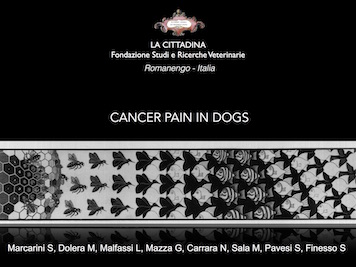CANCER PAIN IN DOGS
Facing to the extensive data regarding cancer pain in humans, no studies regarding canine patients has be conducted. The aim of this study was to evaluate clinical features of cancer pain in dogs and cats. Single referral institution series of dogs with histologically and imaging defined tumors were retrospectively evaluated. Cancer pain was classified as nociceptive, inflammatory, due to spasm-compression and neuropathic. A Melbourne Measure Pain Scale was applied to grade pain. Contingency tables were generated for categorical variables (breed, sex, grade and type of pain, chief complaint, localisation, histology, imaging, pain site, treatment). Associations were assessed by Fishers exact, Wilcoxon rank sum test, t-test, and one-way ANOVA. 1543 dogs with a tumor were considered. Of these, 42% showed no pain, in 38% pain was a presenting complaint, in 21% pain was not known by owner but demonstrated at clinical examination, in 9% pain was the chief complaint. Pain was slight in 33%, moderate in 15%, severe in 5%. Pain was in 64% chronic, in 33% episodic acute pain in a chronic setting, 3% chronicle. type of pain was in 66% nociceptive, 23% inflammatory, 10% due to spasm-compression and 1% neuropathic. Appendicular osteosarcoma and urethral ulcerated tumors were associated with more severe pain. No correlation between age, breed, sex, presence of metastasis and grade of pain was observed. Pain associated with cancer in dogs seem to be of lesser degree comparing to humans. The different type of pain observed can suggest different treatment modalities.
